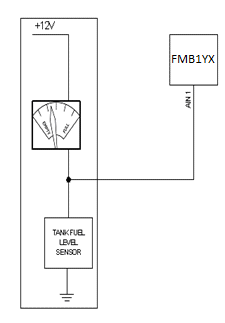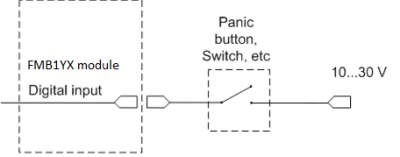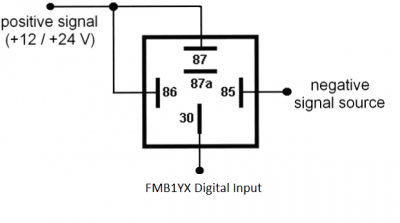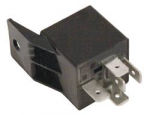FMB140 Accessories: Difference between revisions
(Created page with "{{Template:FMB Accessories|model=FMB140|pic_ds1820=400px|center}} Category:FMB140 Manual") |
No edit summary |
||
| Line 1: | Line 1: | ||
{ | {| class="wikitable" style="border-style: solid; border-width: 0px" | ||
|+ | |||
|- | |||
| style="text-align: left; background: #F6F6FB;" |[[Image:Bw_nb.png|50px]] | |||
| style="text-align: left; background: #F6F6FB;" |Please order accessories separately as they are not included into device package. | |||
|- | |||
|} | |||
[[ | |||
{| class="wikitable" | |||
|+ | |||
! style="width: 300px; background: black; color: white;" |Accessory and its description | |||
! style="width: 500px; background: black; color: white;" |Accessory connection schematic | |||
|- | |||
! style="text-align: left; vertical-align: top;" |Fuel tank sensors | |||
! style="text-align: left; vertical-align: top;" |Fuel sensor connection to {{{model|FMB140}}} | |||
|- | |||
| style="text-align: left; vertical-align: top;" |A fuel tank level sensor which indicates the approximate fuel level on the driver's indicator panel exists in most cars. If the sensor returns analogue signal proportional to fuel level it can be connected to {{{model|FMB140}}} Analog input. After connection to the tank fuel level sensor a calibration is needed because most fuel tank sensors are not linear. Calibration is performed by measuring voltage values resulting from the volume of fuel in tank. | |||
| style="text-align: left; vertical-align: top;" |[[Image:Sch_fmb1yx_lls.png|250px|center]] | |||
|- | |||
! style="text-align: left; vertical-align: top;" |Alarm buttons, door sensors etc. | |||
! style="text-align: left; vertical-align: top;" |Panic button connection to {{{model|FMB140}}} | |||
|- | |||
| style="text-align: left; vertical-align: top;" |Alarm buttons, door sensors, ignition, etc. have two output states: high or low. {{{model|FMB140}}} Digital inputs are used to detect these states. | |||
| style="text-align: left; vertical-align: top;" |[[Image:Sch_fmb1yx_panic.png|400px|center]] | |||
|- | |||
! style="text-align: left; vertical-align: top;" |Relays | |||
! style="text-align: left; vertical-align: top;" |Inverting relay connection to {{{model|FMB140}}} | |||
|- | |||
| style="text-align: left; vertical-align: top;" |In cases when sensor output signal is negative, an additional relay has to be installed to convert negative signal to positive. | |||
| style="text-align: left; vertical-align: top;" |[[Image:Sch_fmb1yx_inv_relay.png|400px|center]] | |||
|- | |||
! style="text-align: left; vertical-align: top;" |Immobilizer relay | |||
! style="text-align: left; vertical-align: top;" |Immobilizer relay connection to {{{model|FMB140}}} output | |||
|- | |||
| style="text-align: left; vertical-align: top;" |When connected as shown on the right hand side, {{{model|FMB140}}} disables engine starter when output is ON. | |||
| style="text-align: left; vertical-align: top;" |[[Image:Sch_fmb1yx_imb_relay.png|400px|center]] | |||
|- | |||
! style="text-align: left; vertical-align: top;" |Automotive relay | |||
! style="text-align: left; vertical-align: top;" |Automotive relay pinout | |||
|- | |||
|- | |||
| style="text-align: left; vertical-align: top;" |An ordinary automotive relay is used to invert input signal or to immobilize engine starter. Note that relays can be 12 V or 24 V capable.<br />[[Image:Pic_relay.png|150px|center]] | |||
| style="text-align: left; vertical-align: top;" |[[Image:Sch_ord_relay.png|250px|center]] | |||
|- | |||
! style="text-align: left; vertical-align: top;" |{{{oneWire|1-Wire devices}}} | |||
! style="text-align: left; vertical-align: top;" |{{{oneWire|I-Button DS1990A connection to {{{model|FMB140}}} }}} | |||
|- | |||
| rowspan="2" style="text-align: left; vertical-align: top;" |{{{oneWire|One of the implemented features on {{{model|FMB140}}} is 1-Wire® data protocol, which enables the use of I-Button DS1990A. | |||
The FMB140 does not have a 1-Wire Power connection, so most other 1-Wire devices compatible with FMB1YX family are uncompatible with the FMB140 (DS1820, DS18S20 and DS18B20).}}} | |||
| style="text-align: left; vertical-align: top;" |{{{oneWire| [[Image:Sch_fmb1yx_ibutton.png|400px|center]] }}} | |||
|- | |||
|} | |||
Revision as of 16:07, 19 February 2020
Main Page > CAN Trackers & Adapters > FMB140 > FMB140 Manual > FMB140 Accessories| Please order accessories separately as they are not included into device package. |







